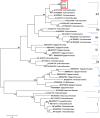Epidemiological investigation of a tap water-mediated hepatitis E virus genotype 4 outbreak in Zhejiang Province, China
- PMID: 27546066
- PMCID: PMC9150197
- DOI: 10.1017/S0950268816001898
Epidemiological investigation of a tap water-mediated hepatitis E virus genotype 4 outbreak in Zhejiang Province, China
Abstract
An outbreak of acute hepatitis recently occurred in a nursing home in Zhejiang Province, China. The objectives of this study were to confirm the outbreak and identify the aetiology, source and transmission patterns. All residents and staff in or near the nursing home during the period from 1 October 2014 to 21 May 2015 were investigated regarding hygiene and for epidemiological information including water and food (eating meat especially pork products). Serum and stool specimens were collected for detection of hepatitis E virus (HEV) antibodies using ELISA and RNA using RT-PCR. Samples that were RNA positive were genotyped. Of 185 senior residents and 24 staff in the nursing home, there were 37 laboratory-confirmed cases during the outbreak. Of these cases, 12 patients (three deaths) were symptomatic with jaundice, a common clinical symptom for hepatitis E infection. HEV strains were isolated from three cases and they formed a single cluster within genotype 4d. A case-control study was conducted to investigate potential risk factors for the outbreak and the results revealed that cases more often washed their dishes and rinsed their mouths using tap water than the controls (P < 0·05). Based on hygiene investigation and meteorological information, it is likely that HEV-infected sewage and faeces contaminated the water network on rainy days. Collectively, these results suggest that the outbreak of HEV genotype 4 infection was most likely caused by contaminated tap water rather than food.
Keywords: Case-control study; genotype 4d; hepatitis E outbreak; tap water pollution.
Figures





References
-
- Balayan MS, et al. Evidence for a virus in non-A, non-B hepatitis transmitted via the fecal-oral route. Intervirology 1983; 20: 23–31. - PubMed
-
- WHO. (http://whqlibdoc.who.int/hq/2010/WHO_IVB_10.14_eng.pdf). Accessed 2015 December 2015.
-
- WHO. (http://apps.who.int/iris/bitstream/10665/129448/1/9789241507608_eng.pdf?...). Accessed 20 June 2016.
-
- Perez-Gracia MT, Suay B, Mateos-Lindemann ML. Hepatitis E: an emerging disease. Infection, Genetics and Evolution 2014; 22: 40–59. - PubMed
LinkOut - more resources
Full Text Sources
Other Literature Sources
Miscellaneous

